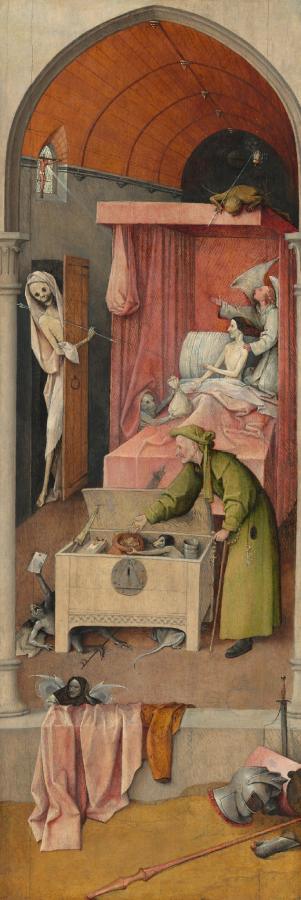Bosch, Hieronymus (c.1450-1516)
Death and the Miser
c.1485–1490
Oil on panel, 93 x 31 cm
National Gallery of Art, Washington
A naked man with ghostly white skin sits upright in a canopied bed set in a narrow room in this tall, vertical painting. Wearing a black cap, he looks to our left in profile toward a skeleton who comes through a door along the left edge of the composition. The man gestures at the skeleton with one hand and, with the other, toward a bag of money held up by a small demon next to the bed to our left. The skeleton wears a white shroud and holds an arrow. A winged angel kneels next to the man in the bed, one hand on the man’s shoulder and the other lifted to gesture at a crucifix hanging in the window over the door. A small devil on the canopy above looks down onto the bed. At the foot of the bed, a man wearing a green robe and headdress drops coins into a sack held by another demon. Three more demons crawl about and hide under the chest. Pieces of armor and weapons lie on the ground to the right in front of a stone ledge in the foreground. Two pieces of clothing drape over the ledge to our left.
In this panel Bosch shows us the last moments in the life of a miser, just before his eternal fate is decided. A little monster peeping out from under the bed–curtains tempts the miser with a bag of gold, while an angel kneeling at the right encourages him to acknowledge the crucifix in the window. Death, holding an arrow, enters at the left.
Oppositions of good and evil occur throughout the painting. A lantern containing the fire of Hell, carried by the demon atop the bed canopy, balances the cross which emits a single ray of divine light. The figure in the middle ground, perhaps representing the miser earlier in his life, is shown as hypocritical; with one hand he puts coins into the strongbox where they are collected by a rat–faced demon, and with the other he fingers a rosary, attempting to serve God and Mammon at the same time. A demon emerging from underneath the chest holds up a paper sealed with red wax — perhaps a letter of indulgence or a document that refers to the miser’s mercenary activities.
This type of deathbed scene derives from an early printed book, the Ars Moriendi or “Art of Dying,” which enjoyed great popularity in the second half of the fifteenth century. The panel may have been the left wing of an altarpiece; the other panels — now missing — would have clarified the meaning of some aspects of the scene, such as the discarded and broken armor and weapons in the foreground. (NGA)
